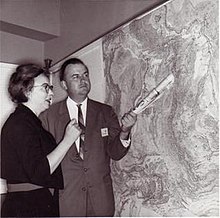
Marie Tharp posed next to a physiographic diagram of the North Atlantic Ocean, late 1950s.
Credit: Courtesy of the Lamont-Doherty Earth Observatory (Felt, H. (2012)
Marie in 2001. Photo credit Bruce Gilbert Biographical information
Biographical information
 Marie Tharp & Bruce Heezen
Marie Tharp & Bruce Heezen
Marie Tharp was born on July 30, 1920 in Ypsilanti Michigan. She attended more than 20 public schools while living in six states and the District of Columbia before graduating and attending the University of Ohio. Marie graduated from the University of Ohio in 1943 with a bachelor’s degree in English and Music and four minors. After graduating, Marie received a rare opportunity to enroll in Michigan’s geology program. A program normally only open to males, but due to the current war had empty seat waiting to be filled. In 1944 Marie graduated with a master’s degree and started her first job at the Standlind Oil & Gas Company in Tulsa, Oklahoma. Once there she discovered much to her dismay that females were not permitted to conduct field work. The only job available was office work where she coordinated maps and data from her male colleagues.
While she was working, she also attended the University of Tulsa where in 1948 she received her second bachelor’s degree, this time in Mathematics. After receiving her degree, she left Tulsa to work as a research assistant at Lamont Geological Laboratory in Columbia University under Dr. Maurice Ewing. While at Columbia University, she met Bruce Heezen, a current geology graduate student. During the next 30 years they continued to collaborate together. In 1959, they completed the first map of the North Atlantic Ocean. Two years later they completed the map of the South Atlantic Ocean and in 1964 they completed the map of the Indian Ocean.
In the late 1960s, Dr. Ewing barred Marie Tharp from working at Lamont. Dr. Ewing also attended to fire Bruce, but was unsuccessful because Bruce has tenure. Marie stated that there was a falling out and there were two sides to the firing and attempted firing story. Dr. Ewing did not allow females to work at sea. So in 1965 Bruce obtained passage for Marie on the R/V Eastward a research vessel owned by Duke University. After Bruce Heezen passed away in 1977, Tharp decided to spend the rest of that year completing the map showing the comprehensive views of the world’s Oceans. After the map was completed in 1977, it was published by the Office of Naval Research. This map is still used today.
Marie Tharp continued to work at the University of Columbia till 1983 when she opened a map making disruption business in South Nyack, New York. She passed away from Cancer on August 23, 2006.
Specific contributions to plate tectonic theory or geophysics
- 1952 Marie Discovers Mid-Atlantic Rift Valley
- 1957 Mid-Atlantic Rift Valley Announced
- 1959 N. Atlantic Physico-graphic diagram published
- 1961 S. Atlantic Physico-graphic diagram published
- 1964 Indian Ocean Physico-graphic diagram published
- 1967 Indian Ocean Panorama published in National Geographic Magazine
Felt,H (n.d.)
Other interesting scientific contributions
Books by Tharp:
With Bruce C. Heezen. “Physiographic Diagram of the North Atlantic.” Geological Society of America Bulletin 67 (1956): 1704.
With Bruce C. Heezen and Maurice Ewing. The Floors of the Ocean. Geological Society of America Special Paper 65. New York: Geological Society of America, 1959.
With Bruce C. Heezen. “Tectonic Fabric of the Atlantic and Indian Oceans and Continental Drift.” Philosophical Transactions of the Royal Society of London. Series A, Mathematical and Physical Sciences 258, no. 1088 (1965): 90–106.
With Bruce C. Heezen. “Physiography of the Indian Ocean.” Philosophical Transactions of the Royal Society of London, Series A: Mathematical and Physical Sciences 259 (1966): 137–149.
With Henry Frankel. “Mappers of the Deep: How Two Geologists Plotted the Mid-Atlantic Ridge and Made a Discovery that Revolutionized the Earth Sciences.” Natural History 95, no. 10 (1986): 49–62.
Other cool stuff you should know
In 1998, she was honored at the 100th anniversary of the Library of Congress' Geography and Map Division. In 1999, she received the Women Pioneer in Oceangraphy Award, awarded by the Woods Hole Oceanographic Institution. In 2001, received the Lamont-Doherty Heritage Award. In 2004, Lamont created the Marie Tharp Visiting Fellowship Program which provides financial aid to promising women researchers.
Bibliography
2006. Remembered: Marie Tharp, Pioneering Mapmaker of the Ocean Floor. The Earth Institute Columbia University. Retrieved February 20, 2014 from http://www.earth.columbia.edu/news/2006/story08-24-06.php.html
2008.Tharp, Marie. Complete Dictionary of Scientific Biography. Encyclopedia.com. Retrieved February 20, 2014 from http://www.encyclopedia.com/topic/Marie_Tharp.aspx
2014 Marie Tharp. Wikipedia. Retrieved February 23, 2014 from http://en.wikipedia.org/wiki/Marie_Tharp
Felt, H. (n.d.). Marie Tharp: Portrait of a Scientist. In Marie Tharp: - GEBCO. Retrieved February 4, 2014, from http://www.gebco.net/about_us/gebco_science_day/documents/gebco_sixth_sc....
Felt, H. (2012). Cartographer’s Ocean Work Not Put on the Map. In Women in Science. Retrieved February 4, 2014, from http://womensenews.org/story/women-in-science/121130/cartographers-ocean-work-not-put-the-map#.
Lippsett, L. 2006. Marie Tharp bio. Mary Sears Woman Pioneer in Oceanography Award. WoodsHole Oceanatic Institute. Retrieved Feb 21, 2014 from http://www.whoi.edu/sbl/liteSite.do?litesiteid=9092&articleId=13407